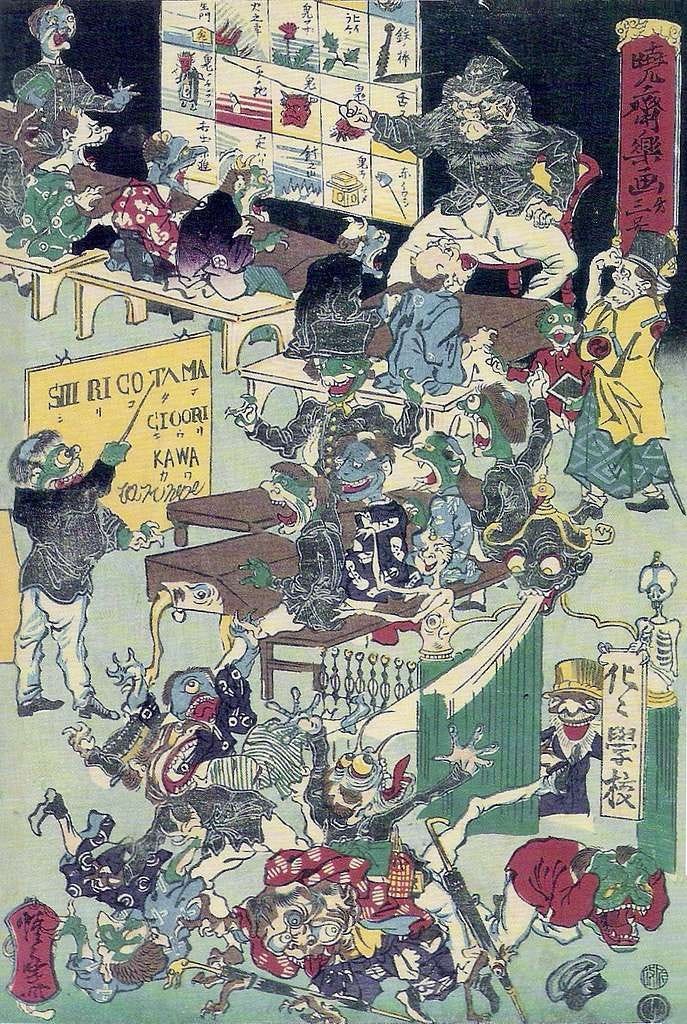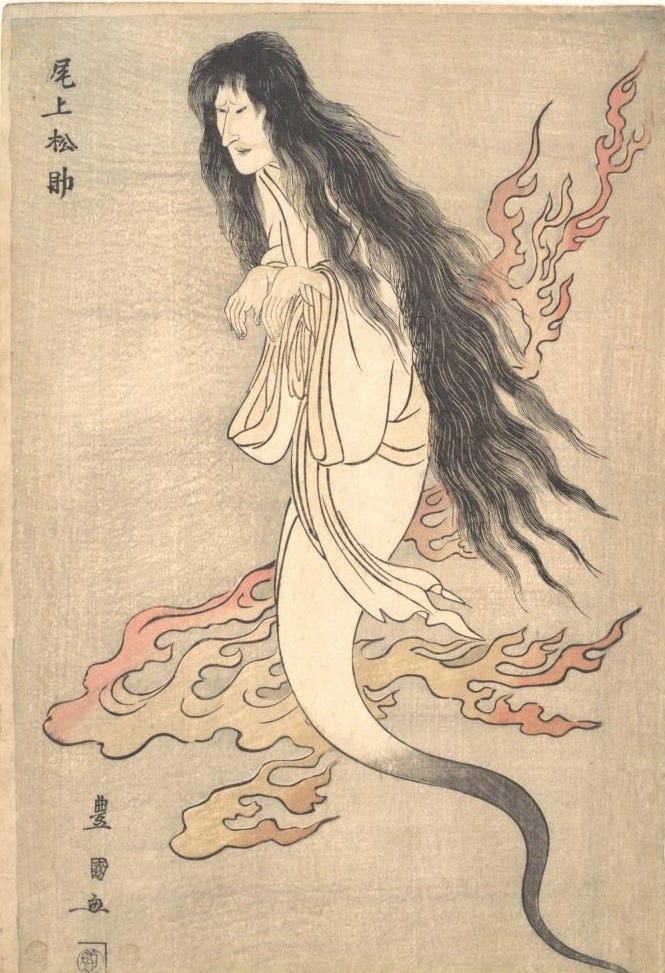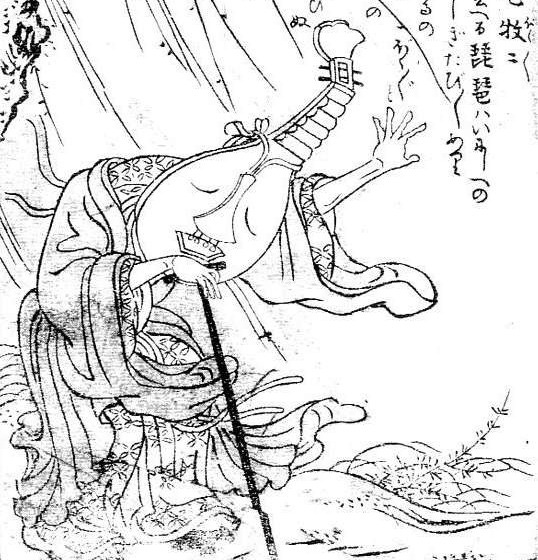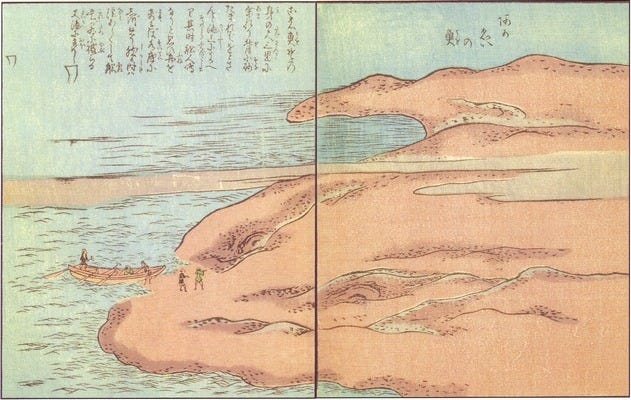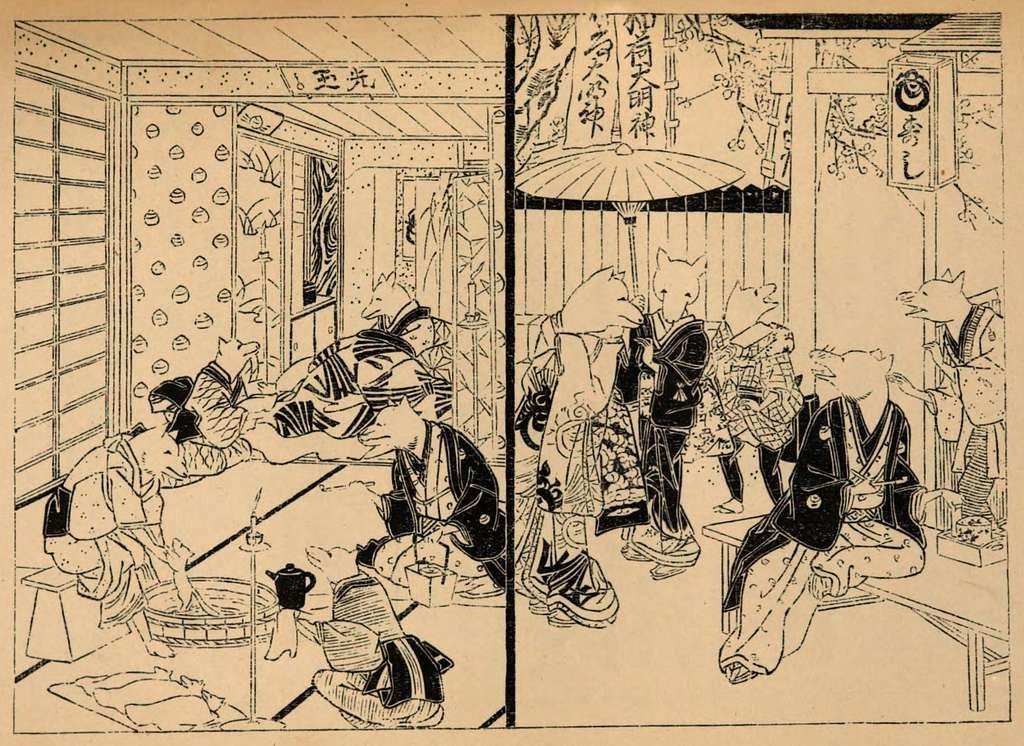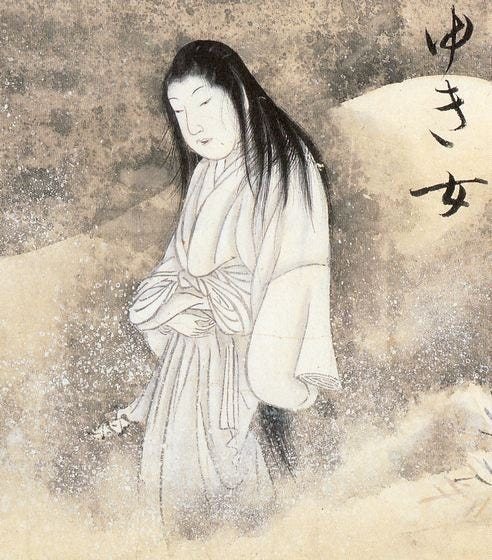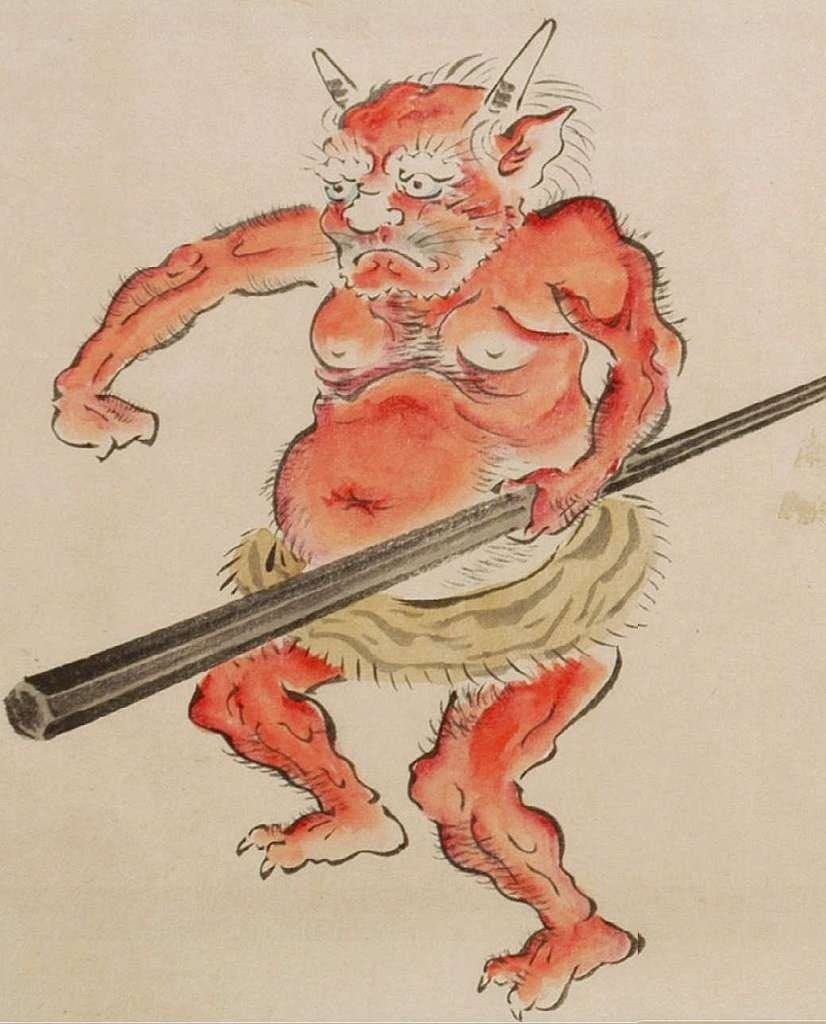What is Yokai? An Introduction to Japanese Monsters and Spirits
Exploring the world of Yokai: From strangest and scariest, to the silliest and mischevious mythical creatures in Japanese folklore!
[Note: This post is too long for email, so some content may not appear. Read this article in a browser or the Substack app for a better reading experience.]
Hi!
Welcome to a Halloween special letter!
Although we don’t celebrate Halloween in our region, I’m a big fan of the supernatural genre, and I love the vibes of this yearly festival– from what I’ve heard and seen on the internet. (Yes, I don’t know much about the history of Halloween. Maybe another topic I’ll look into one day).
And I uh… wish I could cosplay as a ghost and scare people. (But, I won’t because I’m 100% sure I’ll just get scolded by my mom, lol.)
I’m sure when you think of monsters, many of you are thinking of the classic Western monsters such as zombies, vampires, werewolves, or white-clothed ghosts.
But you know what? When I think of monsters and ghosts, the images that pop up in my mind are not of these beings, but are of Yokai— in other words, Japanese spirits, monsters, and supernatural beings.
The fanbase for these supernatural beings is huge, and a lot of people, including me, really love it when supernatural creatures are featured in a story or a show. Because they add an indescribable, mysterious atmosphere and authenticity to the scenes and story.
(“Spirited Away” and some other Ghibli movies by Hayao Miyazaki and “Demon Slayer” by Koyoharu Gotouge are widely popular, and are some of the many examples of modern animated shows and movies featuring creatures and characters based on yokai. The classic children’s TV show, Doraemon, also has made some references to yokai in its episodes. A lot of Pokémons are also based on Japanese yokai.)
Each yokai has a lot of lore and stories– not only in ancient Japanese Folklore– but also often referenced in modern Japanese media, such as anime, manga, video games, commercials, or even mascots for YouTube channels.
Today, I’m going to introduce you to the concept of Yokai and other supernaturals from Japanese folklore, a brief history of them, and also a bit about why they’re a great inspiration to a lot of aspiring manga artists, fiction writers, and creators (like myself).
With that said, let’s get started!
What is Yokai?
Yokai is a very broad term that refers to supernatural beings and strange phenomena in Japanese folklore.
Yokai could refer to Japanese monsters, goblins, phantoms, and demons. But they are all of that– and even more– such as transformed humans, demi-humans, demi-gods, apparitions, spirits, and other supernatural phenomena.
They also come in many forms, such as animals, animated objects, humanoids, spirits, or creatures with animal-like features. A lot of them have the ability to shapeshift or other unique powers that let them trick humans, lure people into danger, or some of them just play harmless pranks on people.
There’s no clear-cut way for one to determine whether a supernatural being could be considered as a yokai or not. Its definition could vary depending on who we’re discussing with and how they would describe yokai.
There is also no other word like yokai in English that could describe this word well enough.
Therefore, just as it’s stated in Yokai.com:
“Yōkai is one of those words–like samurai, geisha, ninja, and sushi–that is best left in its native tongue.”
A brief history of yokai
During the Edo period (1603–1868), yokai was a widely popular topic. It’s the time when the descriptions, writings, and records of yokai sightings– were given form and brought to life by artists through their imaginative illustrations.
Especially– the works of Toriyama Sekien depicting yokai and other imaginative creatures were extremely popular at the time.
His first book, in 1776, the Gazu Hyakki Yagyō (The Illustrated Night Parade of a Hundred Demons), had a huge influence on how people viewed yokai and was used as a reference by a lot of artists and writers.
A lot of people still mistake Toriyama’s depictions of yokai as the original source, while there are even older stories documenting these folklore creatures and phenomena.
During the early 19th century, the popularity of yokai decreased, and stories of these mythical beings were cast aside as mere superstitions of the past.
This decline in popularity lasted until 1960– when a manga by the name, “GeGeGe no Kitaro” by Mizuki Shigeru gained a huge traction and brought back people’s interest in yokai— with each of its main characters being a kind of yokai.
GeGeGe no Kitaro is the classic of all Yokai Manga, which had a huge influence on how manga authors, writers, and creators included yokai in their works– making the entertainment industry re-discover the charm of yokai and Japanese folklore, and how they could be modified to tell unique stories in the form of books, manga, short films, TV shows, and movies.
The differences between Yokai and Yurei
Yurei— translates to “Spirit” or “Ghost”, is often classified as a type of yokai.
But the other day, I learned that the two are probably not the same, and the Japanese view them as different entities.
Unlike yokai, which are mostly creatures with a physically opaque form– Yurei are the spirits of the dead (or even alive humans). Most of them are illustrated as spirits with the appearance of humans. They are either completely invisible to ordinary living humans, or faintly visible with invisible legs. They have the ability to float, and haunt people and places that they have some kind of connection to.
There are different kinds of Yurei as well. Some of them are: Ikiryo, the spirits of alive humans, temporarily leaving their physical body when they’re asleep or unconscious to haunt their enemy or even the person they have a crush on. And Shiryo, which are the evil spirits of the dead.
(You guessed it! This is where my first manga, Shiryo, got its name from.)
I recommend reading this article on Yurei or watching this video to learn more about them!
Although there are hundreds of yokai and spirits, each of them has their own unique appearance, personality, behaviour, habits, and stories.
Just like humans, several creatures of the same yokai kind usually have different personalities. Which makes it a very interesting topic to explore.
Every yokai is different and can range from harmless spirits— to mischievous creatures— to the cruelest demon one can imagine.
I’ll briefly introduce you to a few kinds of yokai I know:
#1. Tsukumogami:
There is a superstition that when a tool, object, or sometimes an animal gets old enough, a spirit comes to inhabit it. The Tsukumogami are yokai that have been an object once, but have been turned into yokai. These yokai appear as everyday objects (such as an umbrella, shogi doors, flip-flops, etc.) with some yokai features and abilities.
#2. Mysterious yokai living in the sea:
There are also Yokai that live in the sea. Such as the Akaei, a massive sea creature resembling a stingray, which was mistaken for an island by sailors due to its enormous size. Or Umi Bozu, which is a large and shadowy humanoid creature, bigger than ships, that sinks boats and ships full of sailors and fishermen.
#3. Yokai that are/resemble animals:
There are also playful, and mischievous animal-like creatures such as the Kitsune (Japanese fox), Tanuki (Japanese racoon dog). And Kappa, which is a green humanoid creature, with a turtle-like shell on its back, and a depression in the top of its head– which is filled with water that acts as their source of energy. The Kappa live in rivers, lakes, and lagoons. If you come across an aggressive one, you can outsmart it by luring it into the land, and bowing to pay respects– which prompts the Kappa to bow in return, emptying out the water on top of their head, and making them unable to move. In some cases, they may even die.
#4. Yokai in the disguise of beautiful women:
And there are also eerie (or kind) yokai in the form of women, such as the Yuki-onna (Snow woman) or the Kuchi-sake Onna (Slit-mouthed woman), which is a terrifying yokai appearing as a woman wearing a mask, or holding a fan to cover her mouth. She would ask you if she’s beautiful. If you answer yes, she reveals her grotesque mouth. “Even now?” she asks. If you answer yes, she will cut the corners of your mouth to look just like hers. If you answer no, she’ll murder you.
Thankfully, there’s a way to outsmart this yokai. Which is by answering her question with “So-so”. It will confuse her long enough for you to escape.
#5. Ogre or demons:
The Oni is one of the most iconic yokai in Japanese Folklore. The word, “Oni” quite literally means “Demon” or “Ogre”. They are cruel and destructive yokai that heartlessly kill, torture, or crush humans with their large iron clubs. The Oni have red or blue skin, crazy hair, and bushy brows, and they are said to live in caves, islands, Hell, and remote mountains.
(As you might already know or have guessed by now, the demons that appear in Demon Slayer are all Oni.)
There are also good Yokai, like the Zashiki Warashi, that bring fortune to the person or place they haunt.
There are also yokai that appear grand and majestic, such as the Nine-tailed Fox (Transformed kitsune), Tatsu (Dragon), or Kirin.
And there are yokai like the Tsurara Onna, which is a beautiful yokai, indistinguishable from humans, that fall in love with a person and marries him.
The possibilities are nearly endless.
Do yokai exist in real life?
Maybe. Or maybe not. The answer to this question will vary greatly depending on who you ask.
Some might say that the yokai existed in the past, some might say that some of the yokai are real while others are superstitions, and some might say that the yokai might still be lurking around in the guise of ordinary objects or animals, unaware to us.
If you ask me, I think the yokai are superstitious beings— which hold extremely interesting lore and stories. I don’t believe they exist, at least until– if I ever encounter one in real life, haha.
(Please don’t be real, Kuchi-sake Onna!)
A recommendation for further reading:
If you enjoyed this article, I highly recommend checking out Yokai.com. Which is a large database of yokai– illustrated, written, and maintained by Matthew Meyer.
A lot of the articles I linked in this post were from that website. (Not sponsored, by the way. I’m recommending the website because I love it.)
It not only has illustrations and descriptions of the appearance of many different kinds of yokai. The unique behaviours, stories, and legends surrounding these supernatural beings are also written. And it’s so interesting that if I could, I would just read them for hours.
To all those yokai enthusiasts out there: I hope you have a good time reading!
Side note:
[All the images used in this article are Public Domain images of old illustrations of yokai, spirits, and Japanese folklore.]
Thank you for reading! I hope you liked reading this article, and I hope it was helpful. Come again next week on Friday for a ✨new post✨
- Harshini


